Why “Ground Factor” Matters
November 17th, 2019
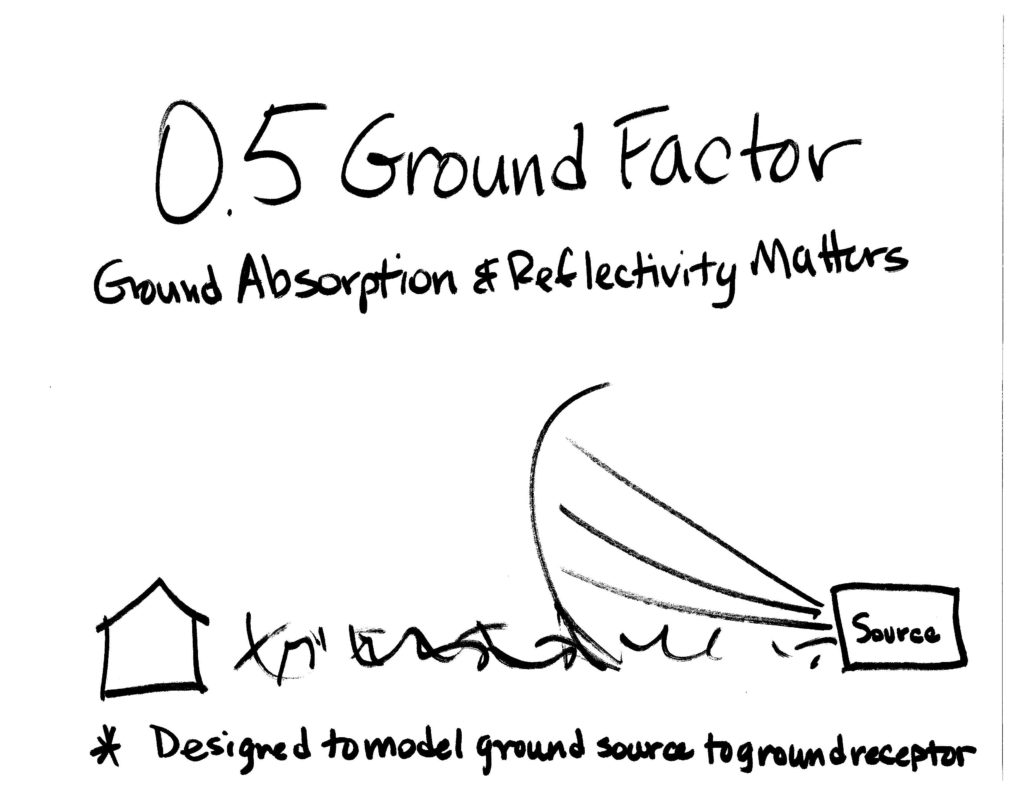
Minn. R. 7030.0400 is the MPCA’s noise rule, setting standards for industrial noise. It was developed to limit industrial noise, from a noise source on the ground to a “receptor” on the ground. ISO 9613-2 was also developed to measure ground based noise reaching a ground based receptor.
A primary input is the “ground factor” set to address conditions on the ground, the ground effect, between the noise source and the receptor:

While there may be some reflected sound reaching the “receptor” (that is such an obnoxious term for people!), the sound from a wind turbine with a hub height of 300 feet or more! That’s a direct path to the “receptor.” The ground, grasses, corn, trees, buildings, do not get in the way.

The ground factor to be used for wind turbines is ZERO.
Dr. Schomer stated this clearly and thoroughly in the Highland Wind docket in Wisconsin (PSC Docket 2535-CE-100).
The use 0.0 of ground factor for wind is standard practice, and that a 0.5 ground factor is NOT appropriate for wind because it’s elevated. This was inadvertently confirmed by Applicant’s Mike Hankard in the Badger Hollow solar docket, also in Wisconsin (PSC Docket 9697-CE-100):

Who cares? Well, it’s bad enough that in that WI PSC Highland Wind docket, when the applicants couldn’t comply with the state’s wind noise limit, they redid their noise “study” using the inappropriate ground factor of 0.5 to give them more compliant numbers — they moved the goal posts, garbage in, garbage out. They think they can do that in Minnesota too, and are trying oh so hard in the Freeborn Wind docket (PUC Docket 17-410).
Last September, 2018 that is, Freeborn Wind did a deal with Commerce, admitted to in its “Request for Clarification/Reconsideration” pleading:
Freeborn Wind requests the Commission clarify its Site Permit to adopt Section 7.4, as proposed by Freeborn Wind and agreed to by the Department and MPCA, in place of the current Sections 7.4.1 and 7.4.2, to both ensure consistency with the Order and avoid ambiguity in permit compliance.
Freeborn Wind’s September 19, 2018, Late-Filed proposal for Special Conditions Related to Noise outlines the agreement reached between Freeborn Wind, the Department and the MPCA on this issue. (fn. citing Late Filed—Proposed Special Conditions Related to Noise (Sept. 19, 2018) (eDocket No. 20189-146486-01).
In this deal, they put language in the permit that was a fundamental shift in noise monitoring, one for which there is no justification under the noise modeling standards, whether state or ISO 9613-2 — that of using a 0.5 ground factor.

The day before the Commission’s meeting, they filed for a “Special Condition,” and oh, was it special:
At the meeting, they presented a chart with made up numbers on it, not supported by any noise study:
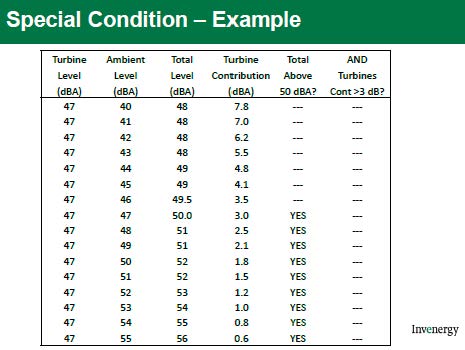
This chart was shown for a few seconds at most, it was not provided in the “Late Filing” above, and there were no copies for parties or the public. Did Commissioners get a copy? Who knows…
The Commission then granted the site permit!!! There were a few rounds before we got to where we are today, with Xcel Energy acquiring the project, and with a new site plan, bigger turbines, and some specific site permit amendments. In its permit amendment application, Xcel Energy is now the owner of Freeborn Wind, and Xcel wants to use larger Vestas V120 turbines rather than the V116.
From testimony in the original Freeborn Wind hearing, and in an Affidavit submitted by Commerce-EERA’s Davis
7. It is generally understood that turbine noise output increases with higher blade tip speeds…
Aff. of Davis, EERA Motion[1], 20181-139379-01.[2]
In its permit amendment application, Xcel Energy is now the owner of Freeborn Wind, and Xcel wants to use larger turbines. In so doing, they have filed a noise study, Attachment E below, utilizing that 0.5 ground factor. Xcel’s claim is that they’re using a 0.5 ground factor because the permit specifies that:
THIS XCEL FILING IS THE FIRST NOISE STUDY IN THE FREEBORN WIND RECORD TO UTILIZE A 0.5 GROUND FACTOR.
THIS XCEL FILING IS THE FIRST NOISE STUDY IN THE FREEBORN WIND RECORD FOLLOWING THE ALJ’s RECOMMENDATION OF DENIAL:

There’s a 3 dB(A) margin of error – even using Hankard’s numbers, look at the yellow lines right up against the homes, and look at the blue 50 dB(A) lines and how many homes are inside of those lines:
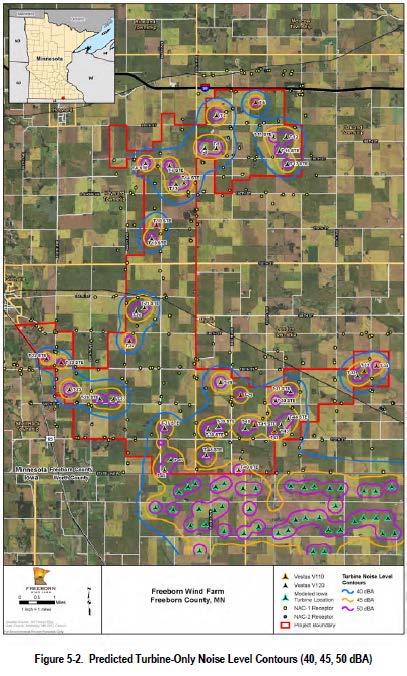
Turbine noise at the hub for the V120s can be maximum of 110.5 dB(A), and serrated edges provide an option to reduce noise (which Xcel says it plans on using for some turbines), per the Vestas spec sheet:
Compliance? Modeling with the improper 0.5 ground factor doesn’t come close to demonstrating compliance, instead it demonstrates a high probability of non-compliance. It demonstrates that using the proper ground factor for wind, it won’t do the modeling, likely (assuredly) because the project cannot comply. Freeborn Wind could not demonstrate that it could comply with state noise standards as originally designed with the smaller wind turbines and the proper modeling ground factor, and now Xcel Energy wants to use larger turbines. Larger turbines are noisier… once more with feeling:
7. It is generally understood that turbine noise output increases with higher blade tip speeds…
…
And now we see, hot off the press, the Plum Creek wind project (PUC Docket WS-18-700), proposed by Geronimo…
Vestas 150 and 162 turbines, 5.6 MW each! The noise for the V150 is a maximum of 104.9 dB(A), and for the V162 is a maximum of 104.9 dB(A), with “sound optimized modes available.” That’s in the brochure:
They have provided a noise study, BUT, much is NOT PUBLIC:
And I wonder why… well, it says that they’re not using a ground factor of 0.0. Look at p. 48 of the sound study above, deep breathe and take a peek:
THEY’RE USING A GROUND FACTOR OF 0.7!
Really…

FALSE!!!
They say it again on p. 62, elsewhere too:
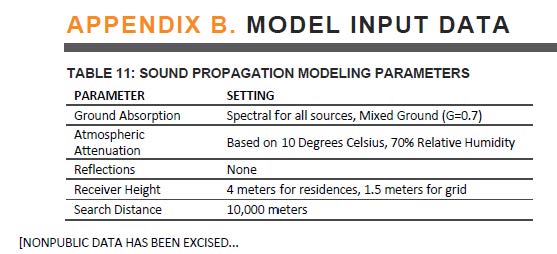
HOW STUPID DO THEY THINK WE ARE?
HOW STUPID DO THEY THINK COMMERCE-EERA IS? …oh… nevermind…
Ayway, here are the sound study maps based on that bogus 0.7 ground factor – look how many homes are affected:
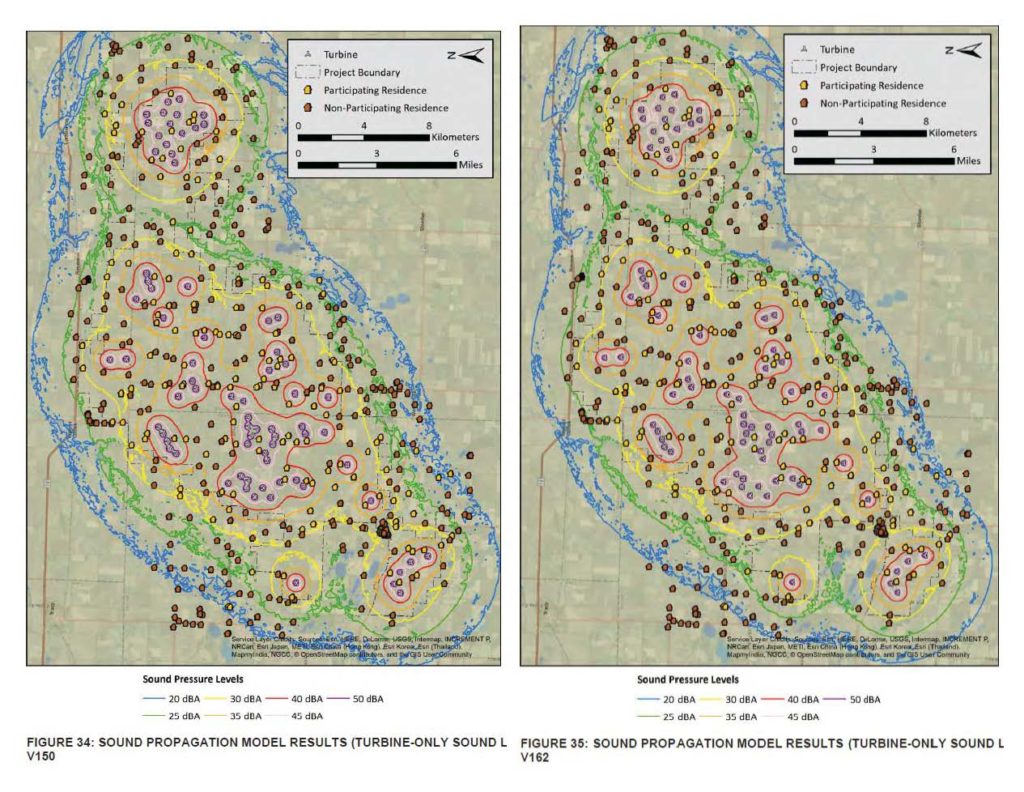
Geronimo gets the gong:
The applicants know exactly what they’re doing.
At least twice in the Freeborn record I have asked whether the Commissioners understand “0.5 ground factor” and “0.0 ground factor” and have been vigorously assured that yes, they do understand. And Commerce-EERA staff? You’re responsible for doing the footwork on these siting applications. Do you understand?
If they do not understand, or misunderstand, they’ve got some learnin’ and edumacation to do. If they DO understand, and are approving site permits knowing that the modeling is off, that ground factor is misused, they’re complicit. They’re knowingly afflicting those who have to live with the noise sound levels that exceed Minnesota state standards.
As we saw in Bent Tree, where the noise standard compliance is in question, it is Commerce’s job to do the noise monitoring and deal with the problem. Once a turbine is up, there aren’t many options other than “shut down the turbines” or “buy out the landowners.” How many landowner buy-outs do you think we need before it’s admitted there’s a problem? Why is it so hard to develop responsible, precautionary, and respectful siting? Why is there resistance? The costs of their failure to do so are… well… we may see exactly what those costs are.
Commissioners and Commerce staff, make sure you know how the state noise standard and ISO 9613-2 was designed, how it is to be used, and what ground factor means.
If you know what it means, and are siting turbines using 0.5 and 0.7, you are responsible.
Leave a Reply